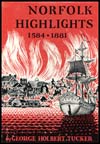Chapter 19
The Dunmore Ball
It's a pity that the biggest social event of pre-Revolutionary Norfolk ended with a sour epilogue two years later. But considering the hectic temper of the times, it couldn't be helped.
The event was the ball given for John Murray, Fourth Earl of Dunmore, Virginia's last royal governor, and his countess in Norfolk in 1774. The epilogue was the bombardment of the town by Dunmore on January 1, 1776.
Dunmore had arrived in Virginia in the fall of 1771 and was joined early in 1774 by Lady Charlotte Dunmore and their children. A few months later the noble couple paid the still-loyal borough a visit, and an account of the event published in the Norfolk and Portsmouth Herald of July 3, 1818, and signed "The Old Burgess," preserves much of the bouquet of the long past social event.
The affair was held in the Mason's Hall on Freemason Street, now the site of the Willoughby-Baylor House. Captain George Abyvon, the Norfolk mayor at that time, had some hesitancy when it came to dancing with Lady Dunmore, so an "express" was sent off to Princess Anne County for Colonel Edward Hack Moseley Jr. (1743-1814), "the finest gentleman we had, to come to town with his famous wig and shining buckles, to dance the minuet with my lady."
Needless to add "all the gentry of our town were there" together with "all the British navy officers . . . with their heads powdered as white as they could be." And when the fiddles struck up, Colonel Moseley led out Lady Dunmore "in her great fine hoop-petticoat" for the first solo minuet, during which "little puss was too cunning for him" and "he was on the wrong scent more than once."
After that, Captain Abyvon was forced to take out Dunmore's daughter, Lady Catherine Murray, for another solo minuet. "But the poor Captain was laboring hard in a heavy sea all the time, and, I dare say, was glad enough when he got moored in his seat."
This was followed by still another minuet danced by Captain Montague of the Royal Navy and another Dunmore daughter, Lady Susan Murray, whom the old Norfolkian remembered forty-four years later as having made "a mighty pretty cheese with her hoop."
Once these formalities were cleared away, the party really got under way. And this is how "The Old Burgess" recalled what happened:
"Then came the reels; and here our Norfolk lads and lasses turned out with all their hearts and heels. This was my cue, and I led out my sweetheart, Nancy Wimble, in my best style, resolved to show all the sprigs of nobility what we Buckskins could do."
At that point, however, a young British officer became so smitten with Miss Wimble's charms that he took her away from her beau, "danced with her every time, and even managed to get her for the country dance, tho' I thought I had engaged her long before."
So Norfolk's most brilliant pre-Revolutionary social event ended on a wistful note as far as the young "Buckskin" was concerned. And this is how he philosophically summed it up:
"To say the truth, I believe the poor girl hardly knew what she did, she was so flattered and wheedled, and made a fool of by her red coat gallant. Indeed I soon found that she thought him worth two of me; and when she saw my Lady Dunmore call him to her, and tap him on the shoulder with her fan, it was really too much for her heart. In short, I was cut out, and cut down -- and stole away from the ball with a flea in my ear. From this time, I saw plainly there was no chance for me. Indeed I could never get near her again; for the dashing officer was with her all weathers, and there was very little room between 'em, you see. Then she took to reading novels, and got a new hoop-petticoat to make her a Lady, and began to study what she could say when she came to stand before the King."
Chapter
20
The Press of a Patriot
Norfolk Highlights 1584 - 1881

See the "Table of Contents" for links to every chapter in Norfolk Highlights 1584 - 1881 by George Holbert Tucker.
